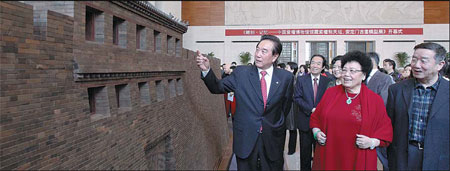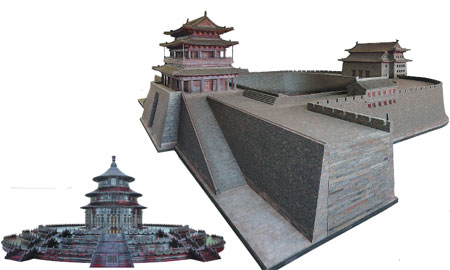Gates of old
Updated: 2013-11-08 08:16
By Sun Yuanqing (China Daily)
|
||||||||
A new exhibition highlights Beijing's ancient entryways in the old city walls, recreated in red sandalwood that can last for thousands of years. Sun Yuanqing explores the details.
For people who never had the chance to see the old city of Beijing, there is now a way to travel back in time. Sculpture and Memory, an exhibition of sandalwood models of Beijing's old city walls and gates, opened in the National Museum of China on Oct 30, evoking memories of the old city.
The exhibition showcases models of the Temple of Heaven and Andingmen. They are the second and the third installments in a series of models of Beijing's ancient architecture initiated by China Red Sandalwood Museum. The first model, Yongdingmen, also known as the Gate of Everlasting Stability, was finished in December.
"When I was a kid, I saw many of these city gates with my own eyes. But how about our descendents, how can they know what the old Beijing was like?" says Chen Lihua, founder of the China Red Sandalwood Museum and chairwoman of Fuwah International Group, a major commercial property developer in Beijing.
The model of the Temple of Heaven, a royal Taoist Temple where emperors prayed for good harvests, is made entirely of precious sandalwood, a heavy and fine-grained wood. It is one-eighth the size of the original building. Weighing nearly 12 tons, it is the largest piece of sandalwood artwork created by the China Red Sandalwood Museum.
The model of Andingmen, the north gate in the former city wall, is one-tenth the size of the original architecture. It features city walls, a barbican entrance, a gate tower and an embrasured watchtower. All the painted parts are illustrated by red sandalwood, which has a gentle glow. The city walls are made of ebony, a wood with variations in color much like the bricks on the old walls. The model weighs about 6.5 tons.
Andingmen, also known as the Gate of Stability, was where the armies once returned from wars. The museum has also finished the model of Deshengmen, the Gate of Triumph, where the troops embarked on expeditions. Deng-shengmen is not on display this time because of limited space.
All the models are made with mortise-and-tenon work, an essential technique of traditional Chinese architecture, Chen says. Woodworkers around the world have used this simple but strong method to join pieces of wood, particularly when the adjoining pieces connect at an angle of 90 degrees.
Born into a noble Manchu family in Beijing, Chen saw the ancient city walls and gates vanish in the latter half of the 20th century. She has always wanted to restore them to the public consciousness.
"We have to leave our memories about old Beijing for the later generations," Chen says.
Chen chose to re-create these buildings in miniature with red sandalwood, because they can last for thousands of years. It took 10 years to complete the blueprint for the models, a process that involved professional assistance from the Palace Museum and the Beijing Municipal Administration of Cultural Heritage.
The capital city of both the Ming (1368-1644) and Qing (1644-1911) dynasties, Beijing had 20 gates in the walls of the outer city, the inner city and the imperial city. In the 1950s, a debate raged among academics, politicians and historians as to whether these city walls and gates should be kept.
Liang Sicheng, the "Father of Modern Chinese Architecture", was a leading advocate to save them. However, Liang and his fellows failed to persuade the authorities, and the structures were torn down to make way for urban construction in Beijing.

Yan Chongnian, a historian and director of Beijing Manchu Institute, says the models are more than reminders of the old city.
"Because of the special quality of sandalwood and ebony, these models can survive for a very long time so later generations will have the chance to get a glimpse of the old Beijing," he says.
This is also the first cooperation between the National Museum of China and the China Red Sandalwood Museum.
"The molding, the materials and the proportions are all impeccable," says Lu Zhangshen, director of the National Museum of China. The models also display "the beauty of Chinese wooden architecture craftsmanship", he says.
Chen says she plans to finish the rest of the city gates in five years.
"If time allows me, I will continue to make the 72 memorial archways of the old Beijing," she says. "And I would then love to be the doorman for the old city of Beijing."
Contact the writer at sunyuanqing@chinadaily.com.cn.
|
Chen Lihua (center), founder of the China Red Sandalwood Museum, is the brain behind the sandalwood artworks on display at the National Museum of China. Lu Zhongqiu / China Daily |
|
Left: The model of Andingmen is one of the highlights at the show Sculpture and Memory. It is about one-tenth scale of the original building and features city walls, an entrance, a gate tower and a watchtower. Far left: The sandalwood model of the Temple of Heaven weighs nearly 12 tons and is about one-eighth the size of the original building. Photos Provided to China Daily |
(China Daily 11/08/2013 page18)

 Post-baby Duchess
Post-baby Duchess
 Victoria Beckham S/S 2014 presented during NYFW
Victoria Beckham S/S 2014 presented during NYFW
 'Despicable' minions upset Depp's 'Lone Ranger' at box office
'Despicable' minions upset Depp's 'Lone Ranger' at box office
 'Taken 2' grabs movie box office crown
'Taken 2' grabs movie box office crown
 Rihanna's 'Diamonds' tops UK pop chart
Rihanna's 'Diamonds' tops UK pop chart
 Fans get look at vintage Rolling Stones
Fans get look at vintage Rolling Stones
 Celebrities attend Power of Women event
Celebrities attend Power of Women event
 Ang Lee breaks 'every rule' to make unlikely new Life of Pi film
Ang Lee breaks 'every rule' to make unlikely new Life of Pi film
Most Viewed
Editor's Picks

|

|

|

|

|

|
Today's Top News
Bank exec describes meeting with Li Keqiang
Russian meteor studied for clues to next one
CIA paying AT&T to provide call records - NYT
Twitter soar 92% in NYSE debut
Registration eased for foreign firms
Possible evidence of Arafat poisoning
Li promises reasonable growth rate
Sex education cartoon an instant online hit
US Weekly

|

|









